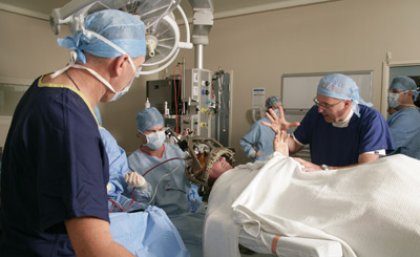
Neurologist Professor Peter Silburn and Neurosurgeon Associate Professor Terry Coyne have performed their 500th deep brain stimulation surgery on a 61-year-old woman with Parkinson’s disease.
The Director from the Asia-Pacific Centre for Neuromodulation (a joint venture between The University of Queensland and St Andrew’s War Memorial Hospital) Professor Helen Chenery said this was an extraordinary achievement unmatched by any other team in Australia.
“Among the top five deep brain stimulation (DBS) specialist teams in the world, Peter and Terry are creating hope for the many people affected by chronic neurological illnesses,” Professor Helen Chenery said.
The world-renowned team say they are motivated to make a difference for patients and their families, and to research how DBS can help people with a wide range of neurological conditions.
“Our 500th patient we operated on together runs a cattle station in north-west Queensland and her Parkinson’s makes it impossible for her to live a normal life,” Neurologist and Professor of Clinical Neuroscience at The University of Queensland, Professor Silburn said.
“DBS has offered her the opportunity to improve her quality of life.”
Deep brain stimulation involves surgically implanting electrodes in a deep part of the brain. This brain “pacemaker” sends electrical impulses to a targeted area on each side of the brain to block the signals that cause the disabling motor symptoms in conditions such as Parkinson’s disease, dystonia and essential tremor.
Professor Silburn and Associate Professor Coyne have also authored or collaborated on numerous papers in prestigious medical journals on their work.
In August 2012, The American Journal of Psychiatry published a major paper co-authored by six world experts, including Professor Silburn and Associate Professor Coyne, on the positive effects of DBS on patients with severe Tourette’s syndrome, an inherited disorder characterised by multiple physical and vocal tics.
The article, Deep Brain Stimulation of Anteromedial Globus Pallidus Interna for Severe Tourette’s Syndrome is one of the largest world studies showing how DBS has successfully treated Tourette’s patients.
“The study involved a dozen patients. This is about turning lives around, so these people can go back to work or study,” Professor Silburn said.
Professor Silburn and Associate Professor Coyne have also published major papers on performing DBS in the very deepest part of the brain – the pedunculopontine nucleus (PPN).
Venturing into the PPN of the brain addresses some of the most crippling aspects of Parkinson's disease, such as gait freezing and postural instability resulting in falls.
The pair were the third team in the world to use DBS in the PPN in Parkinson's patients, but in a world-first, they have gone deeper within the PPN to implant electrodes than anyone else in the world.
They also published a piece on their PPN work in the prestigious international journal Brain in March 2012.
Professor Peter Silburn is Professor of Clinical Neuroscience at The University of Queensland and a world expert in the treatment and research of Parkinson’s disease and related neurodegenerative disorders and in deep brain stimulation.
Associate Professor Terry Coyne is a St Andrew’s-based neurosurgeon and Associate Professor at The University of Queensland with specialist skills in brain and spinal surgery.
BACKGROUND INFORMATION ON DBS
Neurologists and neurosurgeons have used electrical stimulation since the 1960s as a way to locate, stimulate and distinguish specific sites in the brain. Permanent brain stimulation technology was developed in the 1980s.
Deep brain stimulation (DBS) usually uses two surgically implanted medical devices, similar to cardiac pacemakers, to deliver electrical stimulation to precisely targeted areas on each side of the brain. Although the exact mechanism of action is unknown, it appears that continuous stimulation of these areas (or regions) blocks the signals that cause the disabling motor symptoms of Parkinson's disease, essential tremor and dystonia. As a result, many patients achieve greater control over their body movements.
Media Contact: Kirsten Rogan, Communications and Media, University of Queensland Faculty of Health Sciences, 07 3346 4713, 0412307594 or k.rogan@uq.edu.au and Colleen Clur, Niche Consultants, M 0418 253 340, W 3368 1230
.jpg)










